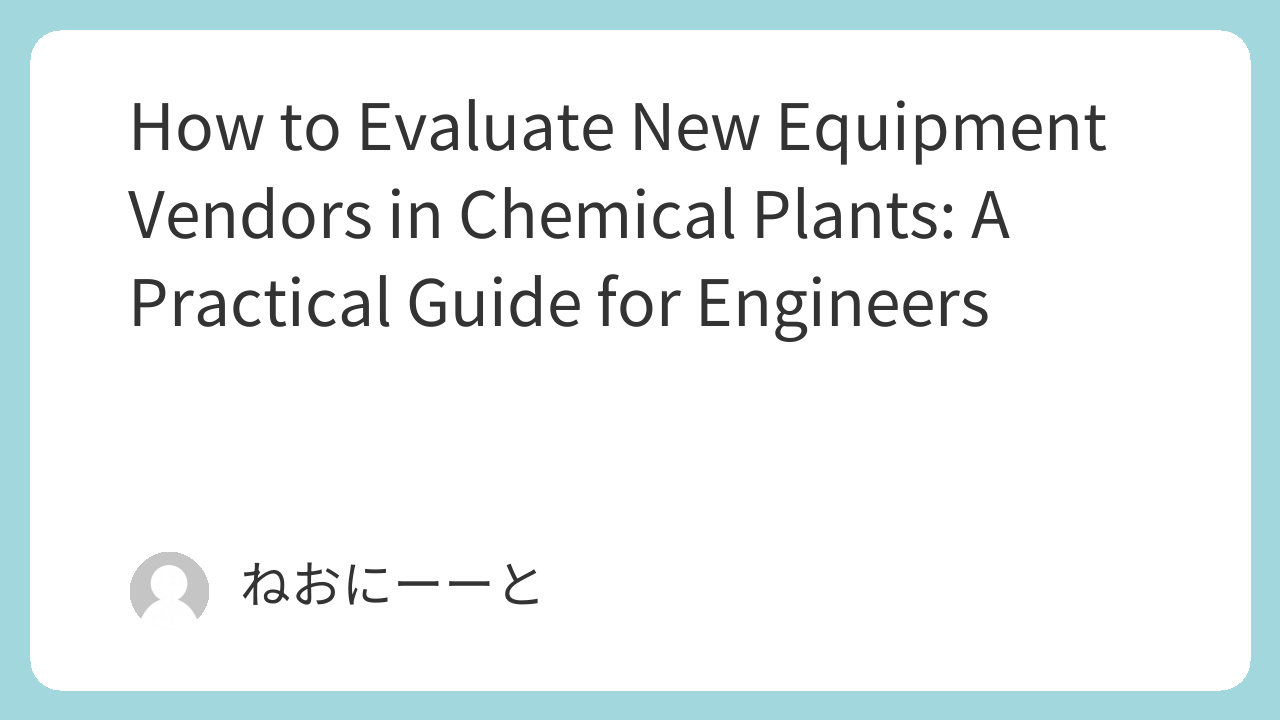In chemical plants, engineers often work closely with equipment vendors. While existing suppliers are the default choice, situations may arise where new vendors need to be considered. Selecting a new manufacturer involves more than just comparing prices — it requires careful technical evaluation to avoid costly mistakes. This article outlines the key points engineers should check before adopting a new equipment vendor, with a focus on pressure vessels and fabricated equipment.
- Fabricated Equipment as a Starting Point
- Lower Risk of Failures
- Easier Expansion Once Successful
- Challenges with Specialized Equipment
- Organizing Internal Specifications
- Reference Drawings and Evaluation
- Confirming Fundamental Plant Requirements
- Vendor Production Capacity and Logistics
- Scheduling and Communication
- ✅ Conclusion
Fabricated Equipment as a Starting Point
Among the wide variety of chemical plant equipment, fabricated items such as tanks and heat exchangers are the most suitable for engaging with new vendors. They are widely used, relatively standardized, and less prone to failures compared to specialized machinery. Starting here allows smoother adoption and reduces risks.
Lower Risk of Failures
In batch processes especially, operating conditions are generally less severe, making fabricated equipment a safer category for first-time procurement from a new vendor. Even if the design differs slightly, the chances of critical issues are low, and there is potential for performance improvement compared to existing suppliers.
Easier Expansion Once Successful
Once a new vendor’s equipment is successfully installed, adoption across multiple plants becomes much easier. Beginning with simpler service conditions and gradually expanding to more demanding applications creates an ideal development path.
Challenges with Specialized Equipment
In contrast, highly specialized equipment often comes with greater variability across vendors. Misunderstandings about design flexibility or user-specific demands can create mismatches, leading to dissatisfaction and adoption failures. Engineers must manage expectations internally and ensure the procurement process does not rely solely on replicating existing designs.
Organizing Internal Specifications
The first task before engaging a new vendor is to consolidate internal specifications. This includes extracting key information from existing drawings, specifications, and past vendor documents. Presenting these requirements in a neutral, vendor-agnostic format helps streamline communication and prevents reliance on tacit, individual knowledge.
Reference Drawings and Evaluation
Reference drawings provided by the vendor can serve as useful evaluation tools. While major issues are unlikely in fabricated equipment, subtle differences in welding, finishing, or assembly may require further checks, mock-ups, or site visits.
Confirming Fundamental Plant Requirements
Engineers should always return to the plant’s fundamental design philosophy when deciding whether to approve deviations from existing standards. Failure to clarify these requirements often results in conservative decisions and missed opportunities with new vendors.
Vendor Production Capacity and Logistics
Beyond design, vendor capacity and location are critical. Plant engineers should verify:
- Factory operations and stability
- Lead times for estimates, drawings, revisions, and fabrication
- Proximity to the plant for installation support and troubleshooting
Local vendors may offer significant advantages in terms of cost, response time, and onsite installation services.
Scheduling and Communication
New vendors may face inevitable hurdles in their first engagement. Transparent scheduling — from estimate preparation to final inspection — and sharing lessons learned internally are vital to building a stable long-term partnership.
✅ Conclusion
Adopting new equipment vendors in chemical plants carries risks but also significant opportunities. Fabricated equipment is the best entry point due to its lower risk and broader industry use. Success requires engineers to:
- Consolidate and standardize internal specifications
- Verify technical and production capabilities of the vendor
- Align decisions with the plant’s fundamental requirements
By approaching new vendor adoption strategically, engineers can diversify procurement sources, reduce risks, and strengthen long-term competitiveness.

Comments